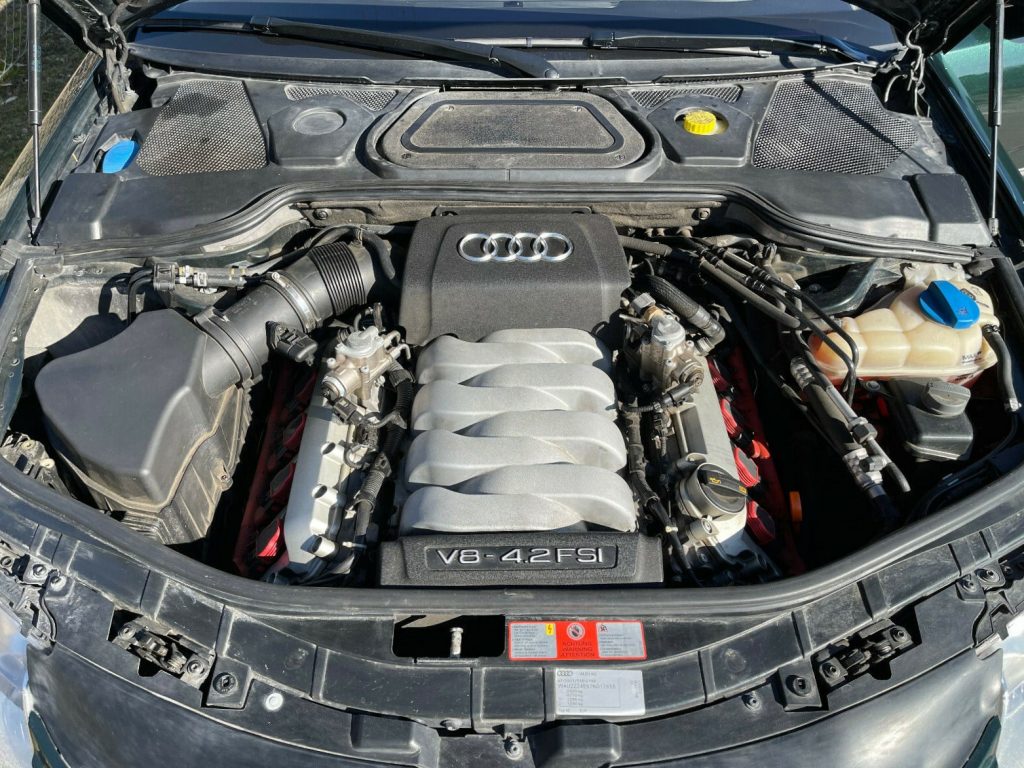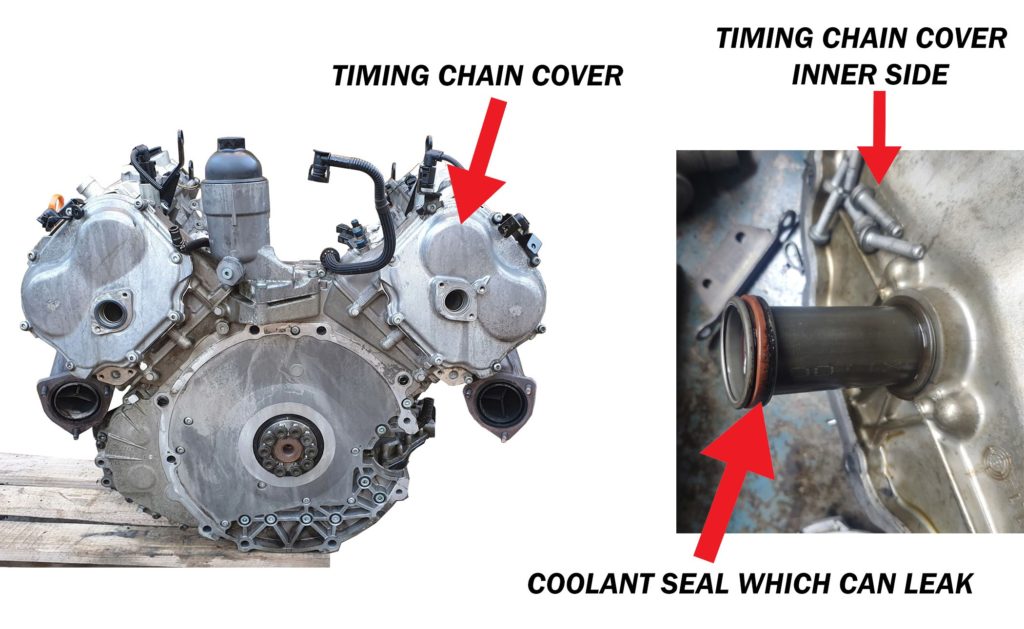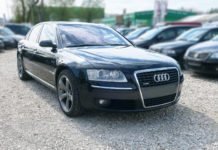In this article you we will look at the most common issues of the widely used 2 variations of the 4.2 V8 petrol engines which you can find in a number of VW group cars such as: Audi A8 D3, Audi A6 C6, 1st gen. Audi Q7, VW Phaeton or in the 1st gen. VW Touareg.
In the Audi A8 D3 you can find 3 versions of these engines:
3.7 V8 (port injection, timing belt)
4.2 V8 (port injection, timing belt)
4.2 V8 FSI (direct injection, timing chain)
The 3.7 l V8 is basically the same as the 4.2 V8, so they can have the exact same issues.
4.2 MPI V8 – 235 kw

This is an older, but still a pretty simple engine. Of course, it can have it’s own share of issues, but if you are gonna fix them in time and if you are gonna do the regular maintenance in time then this engine can last up to 300 000 km, 400 000 km, and I shit you not, even to 500 000 km. So let’s move onto the issues it can have:
1. spark plugs, ignition coils, timing belt
-The spark plugs and the ignition coils are gonna fail at some point, and in this case you will experience misfires. But to minimize ignition coil failure you should definitely replace those damn spark plugs after MAX. 60 000 km (even though replacing them even earlier is even better).
-This engine has a timing belt which you should replace every 120 000 km with the water pump, all the pulleys and the pulley screws obviously. (If you are gonna ignore this interval then sooner or later the belt snaps and destroy your engine)
2. INTAKE MANIFOLD ARMS
-The plastic arms mounted in front of the variable intake manifold can break. This is a minor issue, but it’s good to keep it in mind and eventually replace these arms preventively with aftermarket metallic linkages.
3. WORN CAM CHAIN TENSIONERS
-Despite of the timing belt, these older engines also have chains on the camshafts which have a chain tensioner/actuator on the end of them. So, there are 2 chain tensioners in this engine and these tensioners can simply fail-usually just after 200 000 km or 230 000 km. The early symptom of the worn tensioners is that usual short rattle at engine start. This means, that if you hear the rattle then it’s a good idea to replace these parts sooner than later, since if they fail completely then you can easily end up with a seriously damaged engine-bent valves and shit.
“you can also check the timing values via an OBD scanner (if the values are shit then the tensioners are worn)”
4. OIL, COOLANT LEAKS
-Oil leaks:
- valve cover gaskets
- oil pan
- rear main seal (engine out to fix this)
-Coolant leaks:
- oil cooler/oil filter housing pipe leak
A plastic pipe connected to the oil cooler will sonner or later crack and leak coolant. The good thing is that you can buy an aftermarket metallic pipe = cheap. The bad thing is that replacing this pipe is not easy and the dealer is gonna remove the engine to fix this = expensive (but a good independent mechanic is able to replace this pipe without removing the engine).
5. vacuum leaks, PCV
-As the other older petrol engines, this one also will have sooner or later issues with the various vacuum leaks and with the faulty PCV, but this shit is obvious and should not be surprising at all.
WHAT SHOULD YOU CHECK BEFORE BUYING THIS ENGINE
- check the coolant when the engine is COLD /the coolant has to be clear and clean with NO OIL TRACES or oil smell (oil in the coolant = leaking head gasket = expensive repair)/
- listen for the cam chain rattle at start up (rattle = worn cam chain tensioner = bigger chance of engine damage)
- check the engine idle: the idle has to be PERFECTLY SMOOTH (it has to be so smooth that you can put even a coin on the top of the engine like in this video)
- check for oil and coolant leaks
4.2 FSI V8 – 250 kw

This is a newer, a bit more powerful, a bit more efficient, but most importantly – a more complicated engine which has more common problems and which requires a more precise maintenance. What lifetime can you expect from this engine? Well this is a funny question. Generally speaking there is a high chance that these engines are NOT gonna last longer than 250 000 km or 300 000 km. HOWEVER if you would maintain and use this engine the proper way then it can last even up to 400 000 km. The problem with this is the proper maintenance and proper use. What the fuck is this proper maintenance and use? No worries, I will come back to this at the end of this article, but first the issues:
1. spark plugs, ignition coils
-The spark plugs and the ignition coils are gonna fail at some point causing misfires /the same way as on the older V8/ So to minimize ignition coil failure replace those damn spark plugs after MAX. 60 000 km! (or earlier)
2. INTAKE MANIFOLD
-The variable intake manifold in this engine is a complicated piece of shit actually. And why? Well, because of the plastic insides mainly. But long story short:
- the inside of the intake manifold gets dirty over time
- the plastic bits in it are gonna get brittle – break – and fall apart (eventually the bits can be sucked into the cylinders IN THE WORST CASE)
- the 2 electric actuators mounted on front of the manifold can fail too
The only good thing is that these issues are gonna occur usually just after 200 000 km – 250 000km.
3. WORN TIMING CHAIN
-After 200 000 km there is a higher chance that the timing chain mechanism is already worn, so check for a short rattle at cold start (the noise is basically the same as in the old V8 with worn cam chain tensioners)
The chain is located at the rear of the engine, so to replace it you have to remove the whole engine which is gonna cost a couple of thousands if you can’t do it yourself.
If the chain mechanism fails completely then the chain skips and you will end up with either a poorly running or a seriously damaged engine.
4. camshaft adjustment solenoids
-These little assholes can fail too causing misfires usually, but mainly in cars with the longer oil change intervals (so all cars with the ridiculous 20 000 km – 30 000 km oil change intervals)
But the good thing is that: they won’t destroy the engine, you can replace them very easily even yourself, and they are cheap.
5. DIRECT INJECTION RELATED ISSUES
-Since this engine has a more complex direct injection, you can expect the following addtional funny “features”:
- carbon build up: After 200 000 km (but sometimes even after 150 000 km) – this is gonna cause misfires and loss of power. To clean the intake valves from carbon you have to remove the intake manifold so this can cost around 400 €.
- faulty injectors: After 200 000 km – 250 000 km. The injectors will get clogged up or in some cases they can also leak. Leaking injectors will cause: fuel in oil, excessive fuel in catalytic converter, later destroyed catalytic converter, in the worst case also a damaged engine. Either way, the faulty injectors will cause misfires and loss of power.
- leaking/faulty HPFP: There are 2 high pressure fuel pumps on the top of the engine. Mechanically they are usually fine, but they can slowly leak fuel from the solenoid valve which is bolted onto these pumps high pressure fuel pump fuel leak location video + rarely they can fail too causing: bad/rough engine start and rough idle.
6. OIL, COOLANT LEAKS
-You can expect oil leaks from:
- valve cover gaskets
- oil pan
- oil filter housing bottom gasket (intake manifold out to fix this)
- oil cooler o-rings (lot of things out to fix this)
- rear main seal (engine out to fix this)
- rear timing chain covers (lot of things out to fix this /or engine out to fix this)
-The coolant leaks are not that common, but some random hoses or the water pump will leak at some point.
7. COOLANT LEAK WHICH CAN KILL THE ENGINE
-Behind the engine there are the timing chain covers. These covers do have a hole in them thru which the coolant flows. This would be fine, but it’s not. It’s not fine, since the coolant seal on these covers can fail and let the coolant leak directly into the engine-into the oil. Long story short: If you don’t catch this early then you will end up with a destroyed engine.

8. vacuum leaks, PCV
-This engine also will have sooner or later issues with the faulty PCV + various vacuum leaks (-the intake manifold or some plastic hose can leak).
WHAT SHOULD YOU CHECK BEFORE BUYING THIS ENGINE
- check the coolant when the engine is COLD /the coolant has to be clear and clean with NO OIL TRACES or oil smell (oil in the coolant = leaking head gasket = expensive repair)/
- listen for the timing chain rattle at start up (rattle = worn chain mechanism = bigger chance of engine damage)
- check the engine idle: the engine has to be very smooth on idle (the same way as the older 4.2 V8) however keep in mind that this engine is a bit louder on idle – it’s because of the direct injection, so you will hear a pretty noticeable ticking sound but don’t worry, this is normal and it’s the part of the direct injection magic
- check for oil and coolant leaks
But I still want this 4.2 FSI engine!
Well, ok. Despite all of these issues I can perfectly understand if you still want to buy a car with this engine. I mean cars with these engines are newer – usually facelifted models, and they are often even more equipped than the cars with the older V8. So is it worth it to buy this newer 4.2 l FSI ? Well, let me put it this way: if you are gonna find a car with this engine which has around 150 000 km (can be even 170 000 km) and if it’s in a good condition (-running smoothly, plenty of power and shit), and if you will:
- change that damn engine oil every 8 000 km
- use the engine mainly on longer distances
- after warming up, occasionally rev the engine up properly
- and pay attention to the early signs of issues
then you will minimize most of the issues this engine can have, which means, that there is a high chance that you will get another 100 000 km from it without major problems. But this doesn’t mean that you won’t have any issues with it obviously – so you need to be ready either financially or with having time to fix the stuff, because sooner or later shit is gonna break, leak or rattle.














